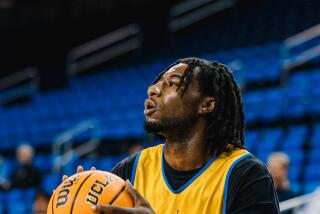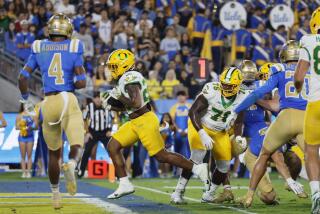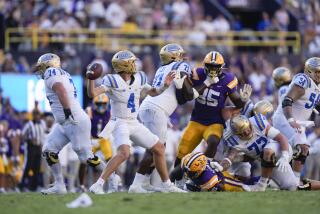Red Sanders’ impact on UCLA football has lasted well past his death, 60 years ago Tuesday
The darkest day in UCLA football history started with a coaches’ luncheon on campus. While Ohio State’s Woody Hayes, Oklahoma’s Bud Wilkinson and other top college coaches assembled in Chicago for a yearly all-star game, Henry Russell “Red” Sanders stayed behind in Westwood.
Sanders reasoned that his Bruins, still grappling with multiple-year sanctions for making payments to players that exceeded the allowable amount, needed his attention a little more than a month before the 1958 season opener.
People who had watched UCLA solidify its standing as the preeminent program in Southern California despite those sanctions thought the coach was needlessly worried.
Sanders had ended USC’s dominance in the crosstown rivalry, his teams going 6-3 against the Trojans after the Bruins had previously won only two games in the series dating to its start in 1929. He guided UCLA to two Rose Bowl appearances and its only national championship, in 1954, while featuring the only team in college football history to lead the nation in both scoring and scoring defense. In nine games that season, the Bruins outscored opponents 367-40.
Along the way, Sanders became a bigger deal on campus than John Wooden, the basketball coach who would become a legend. Though famously gruff with his players, Sanders could be sociable and liked to mingle with Hollywood luminaries. His molasses drawl befitting his Southern roots, Sanders favored Dixieland music and Jack Daniel’s whisky whenever he wasn’t inventing ways to defeat the next opponent.
Sanders originated the squib kick, the 4-4 defense and two of the most iconic quotes in football history — “Winning is not the most important thing, it’s the only thing” and “Beating ’SC isn’t life or death, it’s more important than that.” After nine seasons at UCLA, Sanders, 53, was winning big in the rivalry and at life; he had just been awarded a more lucrative version of the 10-year contract he had signed the previous year.
The coach appeared buoyant as he left the campus luncheon on Aug. 14, 60 years ago Tuesday, without saying where he was headed.
At about 4:30 that afternoon, his whereabouts became known as the news that would change the team’s trajectory for nearly a decade started to trickle out through radio reports.
Sanders was dead.
::
Sanders seemed like a suitably anonymous coach for UCLA when he was hired before the 1949 season.
He had compiled a 36-22-2 record in six seasons at Vanderbilt, his successes not making much of an imprint on the West Coast. One writer described Sanders’ arrival in Westwood in the Los Angeles Times as having been accompanied by fanfare equal to the sun rising that morning: “A male, Caucasian, age 43, was hired yesterday as head football coach at UCLA.”
The Bruins weren’t any more fashionable, winning more than five games only once in the six seasons immediately preceding Sanders’ hiring. But Sanders’ first UCLA team, comprising many servicemen from World War II, went 6-3, leading Florida to unsuccessfully try to lure away the coach with a hefty raise from the contract that was paying him $12,000 over three years.
By his second season, Sanders’ Bruins were no longer a sleepy little outfit. They throttled USC 39-0, a startling reversal of fortunes in a rivalry long owned by the Trojans.
“It was the toughest team that we ever played, every year,” Rex Johnston, 80, who played halfback for USC from 1956-58, recalled of UCLA under Sanders. “Big, strong and fast and hit hard.”
Sanders had a gift for spotting talent as much as accruing it. He plucked Milt Davis off the track team and put him at defensive back, where he would go on to star in the NFL, and made a position switch that helped turn Donn Moomaw into a two-time All-American.
“He put me on at linebacker,” said Moomaw, now 86, “and the rest is history.”
The Bruins ran the already outdated single-wing offense, relying on precision instead of deception. Their defense featured four linebackers ready to pounce on any ballcarrier who might get past the four linemen.
One similarity between Sanders and Wooden was their love of details.
“You’d take so many steps here and they’re this long and [Sanders] would demonstrate these things,” said John Peterson, center and captain of the 1954 national championship team. “So he was a real perfectionist when it came to execution of plays.”
No one seemed to mind having a stickler as coach given the Bruins’ success. Their 1953 season ended in the Rose Bowl, where they narrowly lost to Michigan State. They won a share of the national title the next season after becoming the first unbeaten and untied team in school history.
While the United Press International coaches poll picked the Bruins No. 1 in the nation, the Associated Press bestowed that honor upon Ohio State. UCLA couldn’t meet the Buckeyes in the Rose Bowl because the Bruins had appeared in the game the previous season and there was a no-repeat rule in effect at the time.
::
The taskmaster also possessed a lighter side. Sanders liked to poke fun at his players, once telling the linemen they ran “like a bunch of Easter bunnies” and scolding another player for running up to an opponent “like you were trying to borrow money from him.”
The heights and weights on the team’s official roster were also something of a joke. Sam Boghosian, who stood 5 feet 9 while playing guard and defensive tackle, remembered Sanders toying with his size.
“According to his printing, I was playing at 192,” Boghosian said, “but I was actually 207.”
Sanders could be equally hard to read.
Times photographer Art Rogers was responsible for reaction shots in game-ending situations, such as when Sanders called upon running back Jim Decker for his first college field-goal attempt in the final seconds of a 1955 game in which the Bruins were trailing Washington. The 35-yard attempt sailed through the uprights, giving UCLA the victory and sending the Bruins to the Rose Bowl, but Rogers returned to his office without the desired shot of Sanders.
“Red never changed expression, boss,” Rogers explained to Times sports editor Paul Zimmerman. “He just turned to [assistant coach] Tommy Prothro, as he calmly lighted a cigarette, and said, ‘Now wasn’t that just fine.’”
Jim Murray captured the essence of Sanders’ reticence in an appreciation piece for Sports Illustrated upon Sanders’ death.
“It is probable he had fewer close friends than any celebrated man in America,” wrote Murray, who later become a columnist for The Times. “He seemed always to be nursing some private disillusionment for which he bore no grudge but which precluded his ever leading with his heart with anyone.”
Members of the motion picture community were among those who attended a testimonial dinner in March 1958 in which Sanders was presented with a new Cadillac for his achievements at UCLA.
“He got enamored with the Hollywood crowd, no question about that,” Peterson said. “He was really taken over by a lot of friends in the industry and he pursued them and that kind of led him astray, I think.”
::
In an instant, the college coaches who convened in Chicago in August 1958 went from missing Sanders to mourning him.
His demise was big news in The Times, a massive banner headline atop the front page reading “UCLA GRID COACH RED SANDERS DIES.” It was deemed more newsworthy than the day’s other top story — the death of 99 people when a Dutch airliner plunged into the Atlantic Ocean while on the way from Amsterdam to New York.
The Times’ story quoted William T. “Pop” Grimes, a convicted panderer who told police Sanders that had come to “talk baseball and football” when the coach suffered a heart attack inside a small room at the Lafayette Hotel on Beverly Boulevard.
Other media outlets reported that Sanders had been lured to the hotel by Ernestine Drake, a woman of about 30 who informed authorities she had been introduced to the coach by Grimes shortly before his death.
Drake, who was wearing a flowered dress and spiked heels, said Sanders complained of the heat and sent her to fetch soft drinks. They were sipping the drinks when the shirtless coach clutched his chest and rolled onto one side of the bed.
The woman ran outside for help and when she returned, Sanders was on the floor. By the time police arrived more than a half hour later, the coach was dead.
A coroner ruled that Sanders died from a small hemorrhage in a branch of his coronary artery. His heart was nearly twice the size of an average heart and displayed signs of advanced coronary artery disease.
Sanders left behind a wife, the former Ann Daniel, whom he called “Miss College Football,” his death coming four days before what would have been their 13th wedding anniversary. The couple had no children.
Boghosian learned of Sanders’ death while en route to a family vacation in Mexico and immediately returned to campus, where flags were lowered to half-staff as officials ruefully pondered the coach’s successor.
“It was utter chaos, utter chaos,” said Boghosian, who served as a pallbearer at the funeral after joining Sanders’ coaching staff upon his graduation. “It was terrible.”
::
The scandalous nature of Sanders’ death made everything around the team hush-hush.
“It was kind of an embarrassment, as far as the university was concerned,” Peterson said. “They kind of swept his name under the rug. They didn’t want to discuss it, that’s for damn sure, or have it out in the press.”
In a move that was widely anticipated, UCLA appointed George Dickerson as Sanders’ replacement. Dickerson had been the team’s senior assistant coach and a former Bruins tackle who was captain during his senior season in 1936.
But the strain of the situation proved overwhelming. One day before the start of training camp, Dickerson was admitted to UCLA Medical Center because of nervous exhaustion. Doctors ordered him to rest for two weeks.
“It was so sudden, it was such a take-on so quick and so suddenly that it was a lot of pressure on him,” Boghosian said.
Upon his return, Dickerson declared himself fit to coach and UCLA to be better than the team that had gone 8-2 the previous season. But the Bruins were upset by Pittsburgh 27-6 in their opener and Dickerson was readmitted to the hospital after UCLA’s third game, a 14-0 loss to Oregon State that dropped the team’s record to 1-2. Doctors said Dickerson had suffered a “bad setback” that would necessitate three months of rest.
Assistant Bill Barnes took over and had more downs than ups during the next seven seasons as coach, when UCLA went 32-36-3. The Bruins wouldn’t come close to matching the sustained level of success they enjoyed under Sanders until Prothro took over in 1965, sparking a return to glory that lasted six years.
Sanders’ 66-19-1 record gave him a .773 winning percentage that remains the best in school history. He was inducted into the College Football Hall of Fame as a coach in 1996. His excellence is remembered each year when UCLA gives out the Red Sanders Award to its most valuable players.
His exploits off the field were universally forgiven by his players, who acknowledged them as a quirk of brilliance.
“His death,” Peterson said, “that was just part of his complexity.”
Times researcher Cary Schneider contributed to this story.
Follow Ben Bolch on Twitter @latbbolch
More to Read
Go beyond the scoreboard
Get the latest on L.A.'s teams in the daily Sports Report newsletter.
You may occasionally receive promotional content from the Los Angeles Times.







